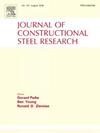Temperature field model for large spatial structures: Experiment, simulation and ANN prediction
IF 4
2区 工程技术
Q1 CONSTRUCTION & BUILDING TECHNOLOGY
引用次数: 0
Abstract
Large spatial stainless steel structures can be susceptible to accidental events such as fires, given their high occupancy, wide range of combustible materials and diverse usage. Consequently, a comprehensive investigation into the temperature field in large spatial stainless steel structures in the event of a fire has been conducted, encompassing experiments, simulations, assessments and predictions. Eight scaled temperature field tests were performed using a pool fire as the fire source, a common scenario in fire incidents. Building on the completed tests, a calibrated CFD model was developed using the Fire Dynamics Simulator (FDS) software and employed to further analyse the temperature field in large spatial structures under various fire powers and radii. A total of 8064 sets of three-dimensional large spatial temperature field data were acquired. Existing temperature field models, both from codes and other research studies, were evaluated against a substantial dataset. The results indicated that current models tend to be conservative, especially in areas near the fire source. In response to these findings, a novel approach utilizing Artificial Neural Networks to predict the 3D spatial temperature field in large spatial stainless steel structures is introduced. In addition, compared with the complex calculation formulae of traditional models, the model proposed herein based on Artificial Neural Networks is more convenient to use in practice and exhibits better accuracy.
求助全文
约1分钟内获得全文
求助全文
来源期刊

Journal of Constructional Steel Research
工程技术-工程:土木
CiteScore
7.90
自引率
19.50%
发文量
550
审稿时长
46 days
期刊介绍:
The Journal of Constructional Steel Research provides an international forum for the presentation and discussion of the latest developments in structural steel research and their applications. It is aimed not only at researchers but also at those likely to be most affected by research results, i.e. designers and fabricators. Original papers of a high standard dealing with all aspects of steel research including theoretical and experimental research on elements, assemblages, connection and material properties are considered for publication.
 求助内容:
求助内容: 应助结果提醒方式:
应助结果提醒方式:


